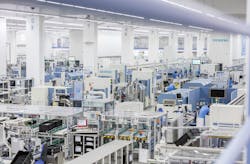Intel Divorces Wind River Subsidiary, a Decade After Acquisition
Wind River’s business is based on real-time operating systems and other high-reliability embedded software used in Internet of Things devices, ranging from sensors in connected cars to massive industrial machines that gather reams of data and send it to the cloud. And for the last decade, Wind River has been part of Intel.
But that will soon change. Wind River announced Tuesday that it had been sold to the investment firm TPG and will return to being an independent company. Jim Douglas, Wind River’s current president, will lead the company after the transaction closes in the second quarter. Other terms of the transaction were not announced.
“TPG will provide Wind River with the flexibility and financial resources to fuel our many growth opportunities as a standalone software company that enables the deployment of safe, secure, and reliable intelligent systems,” Douglas said. He has been in charge since Wind River’s former president Barry Mainz departed in 2016.
Parting ways with Intel allows the Alameda, California-based Wind River to start over. In 2008, Intel acquired Wind River in an $884 million deal designed to improve its position in embedded software. The idea seemed to be that Wind River’s software could be packaged with Intel’s processors for the industrial, automotive, medical, aerospace markets.
Acquiring Wind River and customers including Siemens, Bosch and Boeing seemed shrewd with the growing focus on the Internet of Things. But Wind River, which mostly operated as an independent subsidiary after the deal, never seemed to mesh with its parent company. Intel only fully integrated the business into its Internet of Things group in 2016.
Part of the reason could be that Wind River’s VxWorks operating systems support not only Intel’s processors but also rival architectures like ARM and MIPS. The company also provides embedded versions of Linux, putting it in competition with Microsoft, and the Helix device cloud, which allows hundreds or thousands of devices and systems to be monitored from the cloud.
The other reason could be that the Wind River deal was pushed through by Intel's previous executive team, which had several unsuccessful forays into software. For instance, the company acquired McAfee for $7.7 billion eight years ago, but it eventually divested a majority stake in its cybersecurity business, which grew out of McAfee, in a transaction valued at around $4.2 billion.
Intel has targeted the automotive and industrial markets with renewed vigor in recent years as the growth of its personal computer business has flagged. Wind River has also expanded its software for connected cars. In 2016, the company acquired Arynga, which develops solutions for wirelessly and securely updating software and firmware in cars.
That gave Wind River more software to package together for electronic control units that manage dashboard displays or automatic braking. But the divestment of Wind River could signal that the subsidiary – the largest vendor of embedded software by market share – never gave a sufficient boost to Intel's Internet of Things hardware business.
“This move is designed to sharpen our focus on growth opportunities that align to Intel’s data-centric strategy,” said Tom Lantzsch, senior vice president of Intel’s Internet of Things Group, in a statement. “Wind River will remain an important ecosystem partner, and we will continue to collaborate on critical software-defined infrastructure opportunities.”
About the Author
James Morra
Senior Editor
James Morra is the senior editor for Electronic Design, covering the semiconductor industry and new technology trends, with a focus on power electronics and power management. He also reports on the business behind electrical engineering, including the electronics supply chain. He joined Electronic Design in 2015 and is based in Chicago, Illinois.

